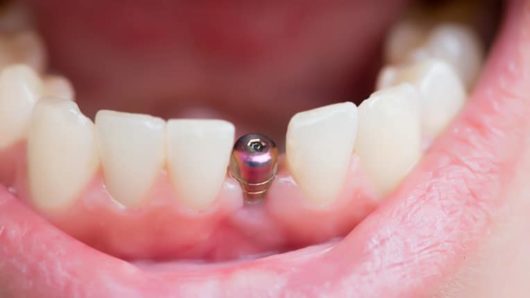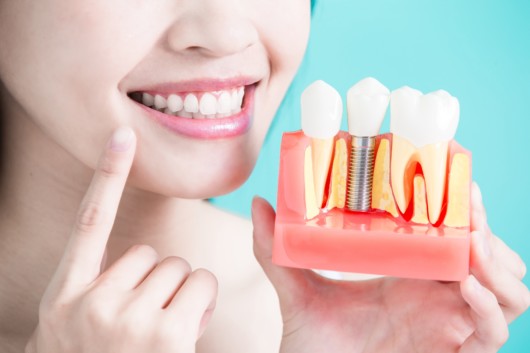Having a perfect smile is usually a top priority for most people. Unfortunately, there are circumstances that get in the way of that. According to studies, 47.2% of adults over the age of 30 have some form of periodontal disease.
Those numbers are staggering and explain why lots of people require cosmetic dentistry to help them improve their teeth. If you’re searching for options that’ll enhance the health and look of your smile, dental implants might be the answer.
Can you have dental implants if you have periodontal disease? We’ll answer that question below.
What Is Periodontal Disease?

Periodontal disease, also known as gum disease, is an illness that damages the bone and causes tooth loss. There are several factors that contribute to periodontal disease. Sometimes it’s a result of poor oral hygiene. If a person has gingivitis and it goes untreated, the bacteria slowly invades the gum tissues causing bone tissue loss.
It also creates small holes for the bacteria to live. These areas are unreachable by your toothbrush and floss. Furthermore, gum disease could be genetic, and most people who develop it do so because it runs in their family.
Signs of Gum Disease
If you suspect that you have periodontal disease, there are a few signs that’ll let you know if you’re suffering from it. The symptoms include:
- Bad Breath
When plaque builds up between your teeth, it creates the ideal environment for bacteria to live and multiply. They create sulfur compounds that give off an odor that results in bad breath,
- Bleeding Gums
Bleeding gums is a tell-tale sign of periodontal disease. If you brush your teeth too hard or floss, it causes bleeding due to sensitivity. Bleeding gums are the biggest warning sign of periodontal disease.
- Loose Teeth
Since periodontal disease creates bone loss, it makes the teeth become loose. The loss accelerates if you grind your teeth or bite down forcefully.
- Inflammed Gums
Inflammation and swelling are other symptoms of periodontal disease. In addition to swelling, your gums will look red as well.
- Receding Gums
If your teeth begin to look longer, it’s likely because the gum tissue has receded. When this happens, the roots of the teeth become exposed.
- Sensitivity
As a result of gum recession, the roots in your mouth become sensitive to hot and cold elements.
How Periodontal Disease Harms Your Overall Health
Periodontal disease starts within the mouth, but it can also contribute to other serious conditions like diabetes, premature birth, and heart disease. Gum disease increases the inflammation within the body, which is a common characteristic of most chronic inflammatory diseases.
Furthermore, the bacteria found within the periodontal holes that are created around the teeth have also been discovered within blood vessel plaques of individuals with cardiovascular disease. Therefore, the inflammation caused by periodontal disease can also help to reduce swelling in other areas of the body.
The best way to prevent gum disease is by brushing your teeth twice a day and flossing regularly. It’s also a good idea to use mouthwash to further kill bacteria within your the mouth. Also, schedule routine dental appointments. If there are any issues with your oral health, your dentist will likely spot it before you do.
What Are Dental Implants?

Dental implants are an artificial tooth root that is put into the jawbone to hold the substitute tooth or bridge in place. They are a great option for people who have lost teeth due to injury, periodontal disease, and other dental issues. There are two different types of dental implants that a person can receive:
- Subperiosteal
This is an “on the bone” dental implant that is put on top of the jawbone using a metal framework. The metal posts poke out of the gums to hold the prosthetic tooth in place.
These dentistry implants are suited for patients who can not wear traditional dentures and have minimal bone height.
- Endosteal
This dental implant is the most common, and it’s put within the jawbone via cylinders, screws, or blades that are surgically placed inside. Each implant holds one prosthetic tooth or multiple teeth. This option is used as an alternative for patients with removable dentures or bridges.
Can You Have Dental Implants With Periodontal Disease?
The answer to the above question is yes. However, you would need to have your gum disease treated before getting dental implants. Periodontal disease causes gum recession and bone loss which reduces your chances of receiving dental implants.
After you the dentist and had the disease treated, your periodontist will decide if you are a candidate for dental implants. Keep in mind that if you have extensive bone loss, you may require a bone graft procedure prior to getting implants. The more extensive the gum disease, the lower the chances of qualifying for implants. If dental implants aren’t an option, dentures are a good alternative.
The ideal candidate for dental implants must have pretty good oral health. There needs to be a sufficient amount of bone in your jaw to support the implant and healthy gum tissues with no periodontal disease in them.
If you’re considering getting the procedure, this article explains the questions you should ask yourself before getting dental implants.
Can you have dental implants if you have periodontal disease? Absolutely. If you’re searching for ways to improve your smile, they’re an amazing option.



